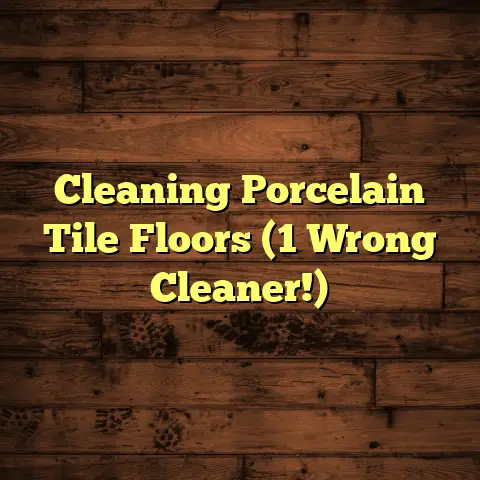How To Remove Laminate Tile Flooring? (Explained)
Removing laminate tile flooring might sound like a tough job, but with the right tools and a bit of patience, it’s something many homeowners can tackle themselves. Whether you’re upgrading your floors or addressing damage, taking out old laminate tile involves a few key steps. First, you’ll need to clear the room and remove any baseboards or molding to expose the edges of the flooring. From there, you can start lifting the tiles—often beginning in a corner or where the flooring was last installed. Depending on whether the laminate was glued down or snapped together, the removal process can vary slightly. In this guide, we’ll walk you through the process step-by-step so you can safely and efficiently remove your laminate tile flooring and prep the space for what comes next.
Why Remove Laminate Flooring?
There are several reasons why one might consider removing laminate flooring. From my experience, some common motivations include:
- Wear and Tear: Over time, laminate can scratch, fade, or become damaged due to heavy foot traffic or water exposure.
- Changing Design Preferences: Homeowners may want to update their home’s aesthetic and choose a different style of flooring.
- Incompatibility with New Décor: If you’re renovating a space or adding new furniture, the existing laminate may not fit well with your new vision.
- Repairing Underlying Issues: Sometimes, removing laminate is necessary to address issues with the subfloor or underlying moisture problems.
Preparing for the Removal Process
Before diving into the actual removal of your laminate flooring, preparation is crucial. Here are the steps I took to ensure I was ready:
Gathering Tools and Materials
I made a list of all the tools I would need before starting the removal process. Here’s an expanded list:
- Pry Bar or Flathead Screwdriver: Essential for lifting planks without damaging them.
- Hammer: Useful for tapping the pry bar when prying up stubborn pieces.
- Utility Knife: Needed for cutting through any glue or stubborn underlayment.
- Floor Scraper: For removing any stuck-on underlayment.
- Safety Goggles and Gloves: Protecting your eyes and hands is crucial during demolition.
- Dust Mask: Helps prevent inhalation of dust and debris.
- Knee Pads: Comfortable support while working on your knees.
I spent around $50 on additional tools, but it was worth it to ensure I had everything I needed.
Creating a Workspace
I cleared the area where I would be working. This meant moving out all furniture and decorations. It’s important to create enough space to maneuver freely without tripping over items. I also laid down tarps to catch dust and debris, making cleanup easier afterward.
Planning for Disposal
Before I started removing the flooring, I checked with my local waste management service about how to dispose of laminate flooring properly. Some areas have specific guidelines regarding construction waste disposal, and I wanted to avoid any fines or issues later on.
Steps to Remove Laminate Flooring
Now that I was prepared, I could begin the actual removal process. Here’s a step-by-step breakdown:
1. Clearing the Area
As mentioned earlier, removing all furniture is essential. I carefully moved out everything from the room, including heavy items like couches and cabinets. Using furniture sliders helped prevent scratches on my hardwood floors beneath the carpet.
2. Disconnecting Baseboards
With the area clear, I turned my attention to removing the baseboards. This step is crucial because it allows you to lift the laminate tiles without damaging the walls. Using my pry bar, I gently pried off each baseboard piece.
I learned that being patient here pays off—if you rush and break a piece, you’ll have to replace it. I carefully labeled each piece so that reinstallation would be easier later.
3. Identifying Plank Orientation
Most laminate flooring is installed in a specific direction. In my case, it ran parallel to the longest wall in the room. Knowing this helped me understand how to lift the planks most effectively.
4. Lifting Planks
I began at one corner of the room using my flathead screwdriver to lift the first plank. Since my floor was floating, each piece easily disconnected from its neighboring planks. I worked methodically across the room, ensuring I didn’t skip any spots.
Sometimes, a plank would stick more than others. In those cases, I found that tapping gently with my hammer helped loosen it without causing damage.
5. Removing Underlayment
After successfully lifting all the planks, I was left with the underlayment. This layer often sticks to the subfloor and can be challenging to remove. Using a floor scraper made this part much easier—it allowed me to get under the material and pry it up.
Challenges Faced During Removal
While the process went relatively smoothly overall, I did encounter some challenges along the way:
Stubborn Planks
Some planks were incredibly stubborn and didn’t want to come up easily. In these situations, I used my utility knife to carefully cut around the edges of the laminate where it was stuck. This approach worked well but required extra caution not to damage surrounding planks.
Dust and Debris
Removing laminate flooring creates a lot of dust, which can be overwhelming if not managed properly. I learned quickly that taking breaks to clean up dust not only made the environment more manageable but also helped me focus better on my work.
Damage to Underlayment
In some sections, I noticed that the underlayment had become damaged over time due to moisture exposure. This situation required me to take extra time inspecting and replacing it once the removal was complete.
Tips for Success
Through my experience, I compiled several tips for anyone considering removing laminate flooring:
- Take Your Time: Rushing leads to mistakes. Steady progress will yield better results.
- Organize Your Workspace: Keep tools nearby and organized so you don’t waste time searching for them during removal.
- Label Everything: If you plan on reusing materials like baseboards or specific planks, labeling them during removal saves time later on.
- Clean as You Go: Regularly stop to clean up dust and debris—it helps maintain a safe working environment.
- Be Mindful of Your Subfloor: After removing the laminate and underlayment, inspect your subfloor for any damage or moisture issues that may need addressing before new flooring is installed.
Post-Removal Considerations
Once I completed the removal of my laminate flooring, I found myself facing several important considerations before moving forward with new flooring installation:
Inspecting the Subfloor
After all planks and underlayment were removed, I took time to inspect the subfloor thoroughly. It’s essential to look for any signs of damage or moisture issues that could affect future flooring installation.
In my case, I found a small area where water had seeped in from an outside source, causing some swelling in the subfloor material. This issue required immediate attention; after consulting with a contractor, we decided to replace that section of plywood before proceeding with new flooring.
Choosing New Flooring
With my old laminate gone and the subfloor repaired, it was time to choose new flooring. This decision posed another set of challenges—so many options exist! Here are some types of flooring I considered:
- Hardwood: Offers durability and aesthetic appeal but often comes at a higher cost and requires professional installation.
- Luxury Vinyl Plank (LVP): Mimics wood at a lower cost with waterproof qualities—an excellent choice if water exposure is a concern.
- Tile: Durable and water-resistant but can be cold underfoot and requires a more complex installation process.
- Carpet: Provides warmth and comfort but can be challenging to maintain in high-traffic areas.
After much consideration and research into costs (ranging from $2 to $10 per square foot depending on materials), installation methods (DIY vs. professional), and maintenance (cleaning requirements), I ultimately decided on luxury vinyl plank due to its balance of affordability and durability.
Installation Tips for New Flooring
With new flooring on order, I began preparing for installation day. Here are some tips based on my experiences:
- Acclimate Your New Flooring: Allow your new planks to sit in the room where they’ll be installed for at least 48 hours before installation; this helps them adjust to temperature and humidity levels.
- Follow Manufacturer Guidelines: Each type of flooring has specific installation instructions—carefully read through these documents before starting.
- Invest in Quality Tools: Just as with removal, having proper tools for installation will make your life easier.
- Consider Hiring Help: If you’re unsure about your DIY skills or feel overwhelmed by the project scope, hiring professionals can save you time and potential mistakes.
Conclusion: Reflecting on My Experience
Removing laminate tile flooring turned out to be an enlightening experience for me. While it presented challenges—like stubborn planks and dust accumulation—it also provided valuable insights into home improvement projects.
In retrospect, compared to carpet removal or tile replacement—which can involve adhesives—laminate proved simpler due to its floating nature. The satisfaction of seeing a clean subfloor after hours of hard work was rewarding, pushing me toward my next home improvement project with confidence.
Ultimately, when considering replacing your flooring options in the future, weigh all factors carefully—from cost, aesthetics, durability, maintenance needs—to ensure you make an informed decision that suits your lifestyle and home design preferences.
Through this journey of removing laminate tile flooring and planning for what comes next, I’ve gained not only practical skills but also an appreciation for taking on home renovation projects one step at a time. Whether you’re a seasoned DIYer or just starting out, remember that every project is a learning opportunity!





